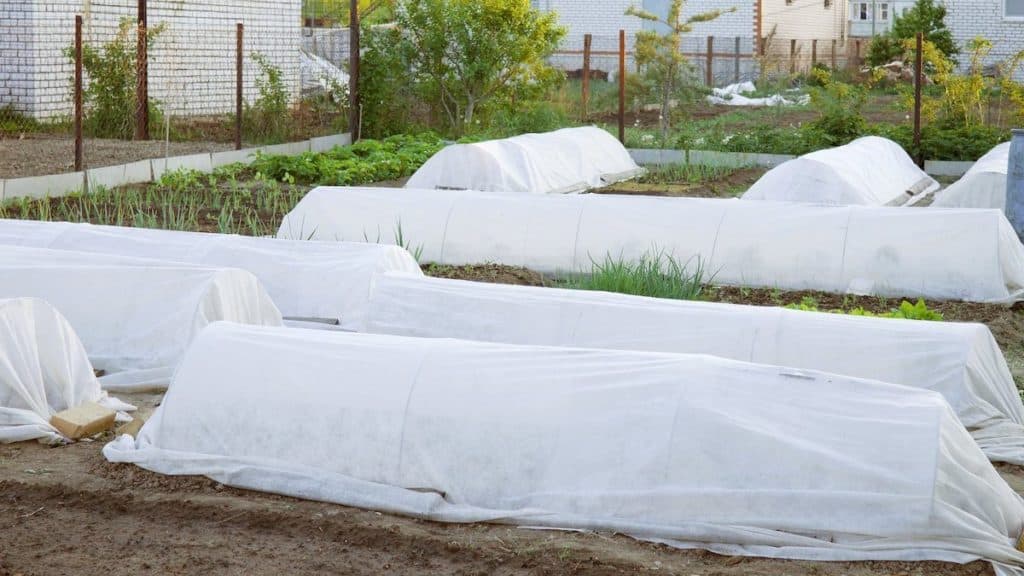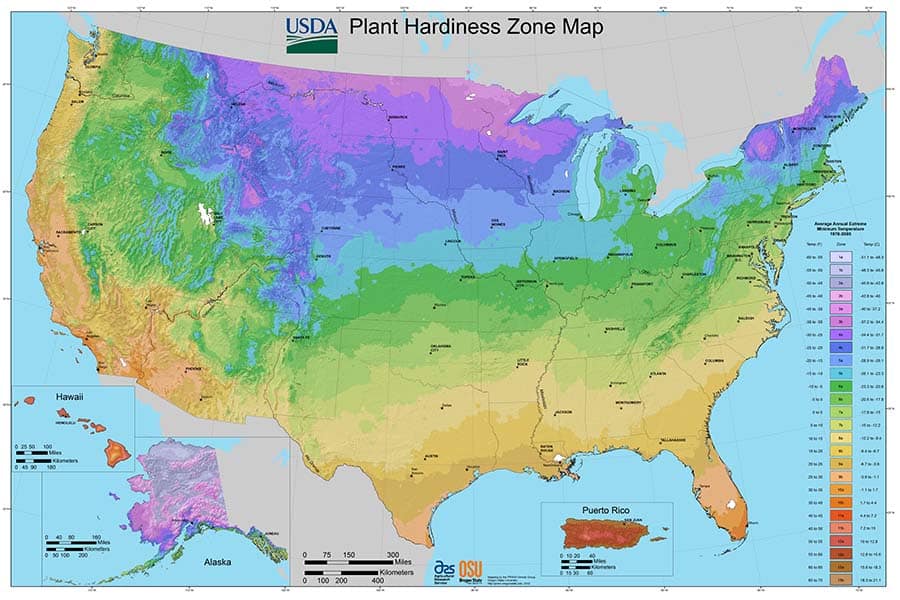Your garden is your baby. You’ve given it life from the time the plants were seedlings, and the last thing you want is for the harsh winter to kill the plants you’ve worked so hard to grow. Luckily, there’s a great solution for keeping your plants warm through the winter.
Frost cloth, sometimes called a frost blanket, traps heat from the sun during the day to help keep plants warm at night. When appropriately used, draping the plant from the top to the ground, the cloth holds in the heat radiating from the soil after a long day of sunshine.
Today we’ll be diving into how a frost cloth works and when you should use it. I’ll also answer some of the most common questions gardeners inquire about when it comes to frost blankets. Let’s jump right in!
Frost Cloth FAQs: Everything You Need To Know
If you’re into gardening, you’ve probably already been using frost cloths for a while. However, you may be surprised to learn that horticultural fleece isn’t very well known in amateur gardening.
Before I dive into the frequently asked questions about frost cloth, let’s talk a bit about it.
Frost cloth is a lightweight fabric placed over plants to help trap heat when the weather cools down. As the name suggests, it’s designed to protect plants from frost. Frost cloths allow light and heat through during the day when the sun is shining and trap that heat once the night comes and the ground begins to release all the heat it collects throughout the day.

Frost cloths may be used to protect plants from progressive frosts as the season continues. Whatever you use it for, its importance can’t be underestimated.
Now let’s discuss some FAQs.
Can Frost Cloth Touch Plants?
The frost cloth should never touch the plants. This is because the cloth collects ice and excessive moisture, and if touching the plants, it will transfer the cold and ice to the leaves of the plants.
The best option is to cover the plants with a cage and place the frost cloth over that. This will provide plenty of space where the heat can stay trapped and keep the frost from transferring to the plants.
Does Frost Cloth Let the Sun Through?
Frost cloth lets almost all the sunlight through. While not all of the light will reach your plants, they’ll still receive about 70% of it per day. Sunlight will pass through the frost cloth and reach the soil. Later, that heat is released from the soil and trapped by the cloth when it gets dark. As a general rule of thumb, the thicker the material, the less sunlight will go through. I’ve also written an article about what thickness to choose when here.
The material of the frost cloth, which I’ll discuss in a moment, is lightweight and allows plenty of light and heat to filter through throughout the day. That said, no need to worry about your plant not receiving adequate sunlight and nutrients when covered by a frost cloth.
Does Rain Go Through a Frost Cloth?
Rain can get through a frost cloth without any issues. You can even directly water your plants through the cloth; however, it can be a bit challenging to gauge whether your plants have received enough water without being able to observe the soil.
Of course, rain works a little differently since it falls all over the ground, so usually, the plants will receive adequate water when it rains. You can also set up irrigation systems underneath the frost cloth.
The only thing to be mildly concerned about is that the root systems may not receive as much water as they should when the plants are clustered too closely. This is because normally wind moves the leaves as it’s raining and allows the water to sink into the soil. When the frost cloth covers the plants, the wind doesn’t reach them either, and the water can end up sitting on the leaves and not getting into the soil enough.
Can I Leave Frost Cloth on During the Day?
You can leave your frost cloth on during the day because it allows plenty of light and water through, so there’s no need for concern. You can even leave the frost cloth year-round if you live in an environment that doesn’t get too hot during the summer.
However, you should proceed with caution if you live in an area that gets hit with hot summers. Remember, the cloth traps heat, and it can wreck your plants under it when it’s already blazing outside.
How Much Warmer Does Frost Cloth Keep Plants?
The frost cloth can maintain temperatures between 30 and 50 degrees Fahrenheit (16 and 28 degrees Celsius) warmer than outside during the day. Of course, overnight, when the sun isn’t beating down through the cloth, it doesn’t keep the temperatures as high.
Overnight, you can expect the frost cloth to keep the temperature between five and ten degrees warmer than outside. While this may not sound like a lot upfront, it makes a big difference, especially when that ten degrees determines whether the plant gets hit by the frost.
What Is Frost Cloth Made Of?
Frost cloths can be made of various lightweight materials, but most often, they’re made from polypropylene or polyester. These materials trap heat well while still allowing light and moisture to go through them.
Sometimes frost cloths will also incorporate plastic into their materials, but usually, these are found in All Purpose Garden Cloths, which are slightly different from frost cloths. However, plastic can help keep heat in even more. Unfortunately, it also blocks light and moisture, which is why it isn’t used as often.
When Should the Frost Cover Be Removed?
You should ideally remove the frost cover in the mornings or once the frost has passed. You can use a frost blanket all throughout the year; however, removing the cover once in a while will ensure that your plants receive as much light and fresh air as possible.
While frost cloths have their purposes and provide a ton of value, you should be cautious about using them for too long. Over time, when used too often, they can begin to detract nutrients from the plants.
How Long Can You Leave Frost Cloth On?
You can leave your frost cloth on as long as necessary, but ideally, you’ll want to remove it once the frost is over. You may want to leave it on throughout winter and remove it once spring comes.
This way, you can protect your plants during the winter while still allowing them to get as much light and nutrients as possible when frosts aren’t happening.
How To Use a Frost Cloth – Step by Step
Now that I’ve answered some of the most common questions about frost cloths, let’s discuss how to use them.
Remember to first set up a cage around your plants. Here’s what you’ll need to do to get started:
- Measure 18 inches (46 cm) from both sides of one row. You’ll want to start roughly 6 inches (15 cm) from one end. You should have about 36 inches (91 cm) across the entire row.
- Make a hole about 12 inches (30 cm) deep on both sides of the row. You can use a digging bar or shovel to accomplish this. You should space holes about 24 inches (61 cm) apart down the entire row.
- Cut a 6-foot (2 meters) piece of PVC pipe or something similar. This can be tough to cut, so it may take extra time.
- Place the pipe in the holes you’ve drilled. Afterward, you’ll bend the pipe around and place the other end in the hole on the other end so that it arks over your plants.
- Repeat this process for every hole. This will form about five arcs over your garden.
- Place the frost cloth over the whole structure. Ensure the cloth reaches the ground, but avoid touching any plants.
- Clamp the frost cloth to the PVC pipe. You’ll want to use snap clamps all along to secure the frost cloth to the pipes.
You can remove the frost cloth when the weather warms or every morning. Clamping and unclamping the cloth from the PVC pipe should be relatively easy.
Can You Use Frost Cloth To Grow Desert or Tropical Plants in a Temperate Environment?
It may come as a surprise, but frost cloth serves a wide array of uses other than protecting your plants from harsh winter temperatures.
One of the neatest ways to utilize frost cloth is to use it during the summer and spring in temperate climates. I briefly discussed using frost cloth throughout the year, and while this isn’t necessarily recommended when you live in more tropical environments, it has its uses when you live farther north.
Frost cloth can be used in environments with cooler summer temperatures, allowing you to grow tropical and desert plants during the year. There are a few caveats to this.
You have to have the right type of soil, for example. You can’t grow a desert cactus in clay, but if you create sand-based soil and other correct conditions, you’ll soon see that these plants will flourish.
When using frost cloth to grow desert and tropical plants, you’ll want to plant them in pots and cover them throughout spring and summer. The heat trapped during the warmer season will allow other plants to flourish, even in a growing zone that they aren’t usually accustomed to.
Essentially, what you’re doing through this method is increasing the temperature and letting the tropical and desert plants feel like they’re in their normal growing environment. All plants have different hardiness zones. You’re raising the hardiness zone and encouraging the plant to grow in an environment where it normally doesn’t.
Is Frost Cloth One of a Kind?
Frost cloth is fairly unique in its material makeup, but that doesn’t mean there aren’t substitutes. While it’s best to use frost cloth to protect your plants, there are a few different items you can use that will give you a similar effect.
You can also use large blankets or bed sheets to protect your plants. If you choose to use these materials, however, there are a few things that you should be aware of:
- Blankets and sheets will block water. They aren’t near as porous as frost cloth, and you can’t expect your plants to receive the same amount of water while covered in this way.
- They will block some airflow. This is especially true if you choose to use heavier blankets.
- Blankets and sheets will limit light. This goes back to what we were just discussing with water as well.
With these things in mind, you can use blankets and bed sheets similarly to frost cloth. These materials will still help to trap heat during the cold months, but unlike frost cloth, they shouldn’t be left on the plants for extended periods.
Moreover, always ensure that there’s plenty of space between the blanket or sheet and the leaves. It’s always best to use a cage, whether using a frost cloth or not.
There are other kinds of gardening cloths available as well. All Purpose Gardening Cloths work similarly to frost clothes, except that they trap heat differently. These aren’t best used to protect from frosts, but they can be utilized in a pinch.
You could also use bubble wrap, but this isn’t suggested since it doesn’t allow air or water to get to the plant. In essence, you’re suffocating your plants while attempting to keep them warm. I’ve written an in-depth article about materials that you can use instead of typical frost cloth here.
Final Thoughts
Frost cloth makes for one of the best items you can use to protect your plants during the harsh winter. Typically, you should use it during the frost, even if this means throughout the entire winter, and then remove the cloth once the temperatures begin to increase again.
Frost cloth does have some substitutes, but it’s always best to use real frost cloth because other materials, such as blankets and bed sheets, can do more harm than good.
Frost cloth boasts many uses, including assisting in increasing temperatures to grow more tropical plants in temperate environments.


